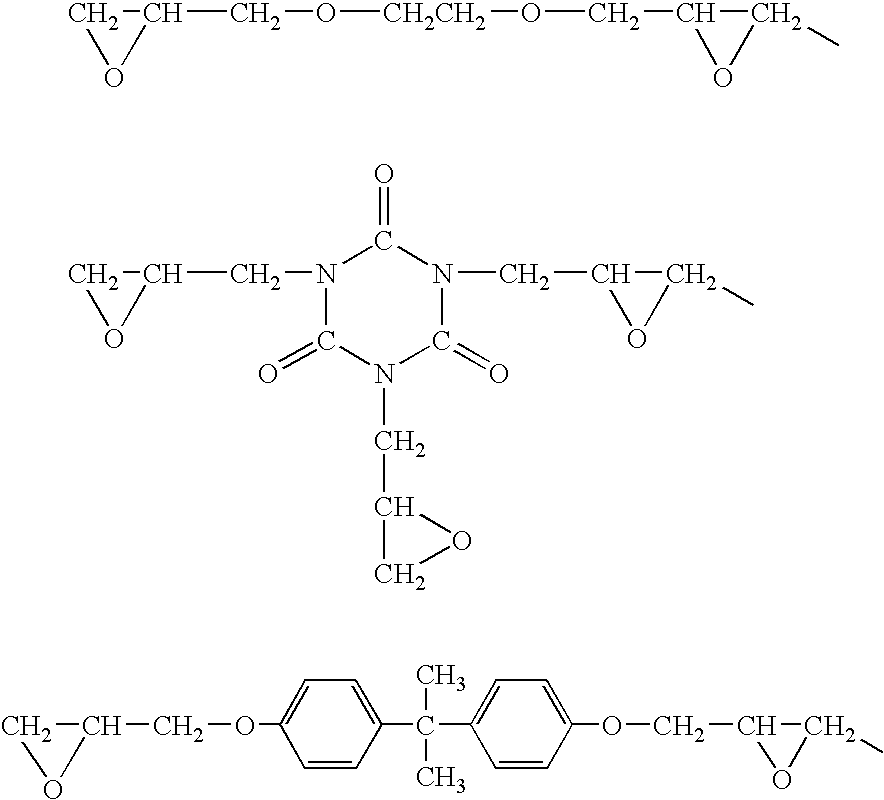Aqueous emulsion resin compositions
a technology of resin composition and emulsion resin, which is applied in the direction of synthetic resin layered products, textiles and paper, powdery paints, etc., can solve the problems of resins and coated films of unfavorable quality in terms of durability and weather resistance, compositions are generally inferior to solvent-based crosslinking type paints in water resistance, solvent resistance, soil resistance,
- Summary
- Abstract
- Description
- Claims
- Application Information
AI Technical Summary
Benefits of technology
Problems solved by technology
Method used
Image
Examples
synthetic example 1
[0080]In a 1-liter pressure-resistant reaction vessel equipped with a stirrer, were placed 500 ml of deionized water and 1.0 g of ammonium perfluorooctanoate. Dissolved air was then removed by repeated introduction of nitrogen gas with applied pressure and degassing. Subsequently, a monomer mixture comprising VdF / TFE / CTFE / CH2═CFCF2OCF(CF3)CF2OCF (CF3)—CH2—OH with a mixing ratio of 74 / 12 / 12 / 2 mol % was introduced into the vessel with applied pressure in such a manner that the internal pressure of the vessel at 65° C. became 2.0 MPa. Next, 0.2 g of ammonium persulfate was placed in the vessel and polymerization was conducted over 5 hours while continuously supplying the monomer mixture thereto in such a manner that the internal pressure of the vessel was maintained at 2.0 MPa. The internal atmosphere of the vessel was then returned to ordinary room temperature and atmospheric pressure to complete the polymerization, giving an aqueous polymer dispersion of the present invention. The so...
synthetic example 2
[0081]An aqueous polymer dispersion of the present invention was obtained by following the same process in Example 1 except that a monomer ratio of VdF / TFE / CTFE / CH2═CFCF2OCF(CF3)CF2OCF(CF3)—COOH was set at 74 / 12 / 12 / 2 mol %.
synthetic example 3
[0082]In a 1-liter pressure-resistant reaction vessel equipped with a stirrer, were placed 500 ml of deionized water and 1.0 g of ammonium perfluorooctanoate. Dissolved air was then removed by repeated introduction of nitrogen gas thereinto with applied pressure and degassing. Subsequently, a monomer mixture comprising VdF / HFP / CH2═CFCF2OCF(CF3)CF2OCF(CF3)—COOH with a mixing ratio of 88 / 20 / 2 mol % was introduced into the vessel with applied pressure in such a manner that the internal pressure of the vessel at 65° C. became 1.8 MPa. Next, 0.2 g of ammonium persulfate was placed in the vessel and polymerization was conducted over 5 hours while continuously supplying the monomer mixture in such a manner that the internal pressure of the vessel was maintained at 1.8 MPa. The internal atmosphere of the vessel was then returned to ordinary room temperature and atmospheric pressure to complete the polymerization, giving an aqueous polymer dispersion of the present invention. The solids cont...
PUM
| Property | Measurement | Unit |
|---|---|---|
| Percent by mass | aaaaa | aaaaa |
| Percent by mass | aaaaa | aaaaa |
| Percent by mass | aaaaa | aaaaa |
Abstract
Description
Claims
Application Information
 Login to View More
Login to View More - R&D
- Intellectual Property
- Life Sciences
- Materials
- Tech Scout
- Unparalleled Data Quality
- Higher Quality Content
- 60% Fewer Hallucinations
Browse by: Latest US Patents, China's latest patents, Technical Efficacy Thesaurus, Application Domain, Technology Topic, Popular Technical Reports.
© 2025 PatSnap. All rights reserved.Legal|Privacy policy|Modern Slavery Act Transparency Statement|Sitemap|About US| Contact US: help@patsnap.com



